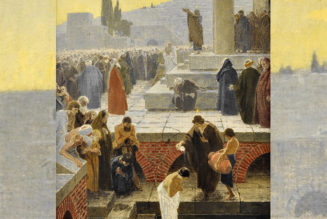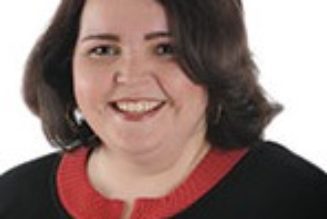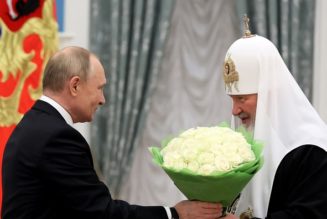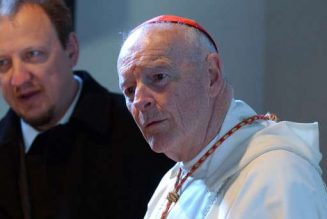When an Indiana priest’s message on the Mass went viral on YouTube recently, the response revealed a hunger among Catholics to know more about the Church’s principal sacramental celebration.
Father Jonathan Meyer of All Saints parish in Guilford, Indiana, was astounded when a 33-minute talk he had given at a Jan. 27 men’s conference in Palm Beach Gardens, Florida, was picked up by the Servants of God YouTube channel in Australia, drawing more than a half million views and 1,432 comments.
“I had no idea it was even happening,” Father Meyer told the Register. “I gave a talk, and the next thing I knew, it was trending like crazy.”
Claiming that more than 90% of Catholics do not fully grasp why they go to Mass, Father Meyer set out in the talk to correct misconceptions and expound on the roots and purpose of the Church’s chief form of worship. In it, he presents 14 “Stations of the Eucharist” he has developed to illustrate the nature of the Mass as the re-presentation of Christ’s sacrifice on Calvary, taking readers through the Bible and highlighting scenes such as the sacrifice of Abel and the Last Supper.
Father Meyer told the Register in his experience most Catholics bring a kind of consumer mentality to Mass, showing up to get what they want: Jesus in Holy Communion. But Christ, he said, is truly present in the Eucharist not just so that Catholics can receive and adore him. Rather, it is so that they can be at the re-presentation of the death and resurrection of Jesus.
[embedded content]
“I think there is this great love of Jesus in the Blessed Sacrament,” he said, “but it is completely detached from the true understanding of his presence being given to us so we could enter into the re-presentation of Calvary.”
When Catholics miss this, he said, they tend to cling to peripheral elements of the Mass like music, homilies or community, making them the focal point.
“All those are great and fruits of a well-celebrated Mass, but none is essential to what is taking place,” he said. “… I go to Mass to go to the passion, death and resurrection of Jesus, to go to Calvary, to go to my salvation. It literally is my salvation. It is the death and resurrection of the Lord, and I have the ability to unite myself to it.”
Father Casey Jones, pastor of St. Elizabeth Seton parish in Naples, Florida, said his observations mirror those of Father Meyer.
“I can tell by the look on people’s faces at Mass,” he said. “You have these blank, glazed-over kind of eyes. Secondly is the casual way in which people approach the Blessed Sacrament. You see people that come up like I’m giving out a number at the deli counter. You see this lack of understanding.”
“People will receive Holy Communion and then bolt right out the door, without even taking time for a moment of thanksgiving,” Father Jones said.
Others, he said, not only leave early, but arrive late — just in time to receive Communion.
“That is a clear indicator they don’t understand the Holy Sacrifice of the Mass because they think about ‘what I can get out of it.’ They’ve missed the notion of sacrifice.”
Brant Pitre, research professor of Scripture at the Augustine Institute and author and presenter of The Mass Explained video series, agreed that many Catholics, especially those who grew up in the faith, know what to do and say at Mass but don’t necessarily comprehend why.
“One of the reasons Father Meyer’s video is going viral,” he said, “is that it is touching a nerve and filling a gap many Catholics have in understanding the Mass as a sacrifice.”
For instance, he said, Catholics who say they go to Mass to receive Holy Communion are not necessarily wrong to cite that as a reason, given the Mass is ordered not just toward the transubstantiation of bread and wine into the Body and Blood of Christ but toward the reception by the priest and the faithful.
“However, many Catholics unfortunately have the idea that we go to Mass only to receive,” he said, “and they forget the Church’s teaching that we go to Mass not only to receive but to offer ourselves in union with the sacrifice of Christ. This is really, really important. It’s nowhere clearer than in the Mass itself, in the Offertory.”
When the priest turns to the faithful and says, “Pray, brethren,” Pitre explained, he is asking them to pray that “my sacrifice and yours be acceptable to God the Father Almighty.”
Yet, he continued, “If you ask most Catholics, ‘What is your sacrifice?’ they would be hard-pressed to answer that. The priest is offering the sacrifice of the Body and Blood of Christ to the Father in the Person of Christ, but it’s not often as clear that we also go to offer sacrifice.”
Quoting the Catechism of the Catholic Church, Pitre said, “The lives of the faithful, their praise, sufferings, prayer and work are united with those of Christ and with his total offering, and so acquire a new value.”
It is especially at the Offertory, he continued, that the faithful are supposed to be bringing their suffering, prayer, the work they’ve engaged in through the week and all their trials and difficulties and offer them on the altar in union with the priest’s offering.
“For me personally, this understanding of Mass not just as reception of Communion but as offering of sacrifice is really transformative for our active participation in the Mass.”
Father Meyer added, “We need the re-presentation of Calvary because we need to take our sufferings and trials there so we know we’re not alone, that there’s a place we can go in our isolation, brokenness and addiction and can unite it to Christ. And this is not just me thinking about Jesus and that he did that one time in history. He allows us to continue to enter into it because we’re all broken, and every day that brokenness continues, and the brokenness of the world continues.”
As he told the men at the January conference in Florida, “I don’t know what cross you have today, but what I do know is that there’s a Mass right now in this world being offered at this very moment, and you can unite that sacrifice and that pain and that wound to that cross, which is your salvation.”
One of the 50 priests who have been serving as “Eucharistic preachers” for the three-year National Eucharistic Revival, Father Meyer said he and the others have been encouraged to preach on the Eucharist as presence, communion and sacrifice.
“Of those three aspects of the Holy Eucharist that the Revival is trying to bring forth,” he said, “the one probably the least understood is the Eucharist as sacrifice, a sacrificial meal that brings us into direct contact with the sacrifice on Calvary.”
He said he is hopeful that the Church, having previously emphasized communion and presence, may now be entering a season in which sacrifice is highlighted.
Even in his own priesthood, Father Meyer said, he doesn’t know if he fully understood the Mass as a sacrifice. Ordained in 2003, he said, “I was fighting with every ounce that I had to try to just get people to believe in the True Presence. If I had it to do all over again, I wish I would have fought the battle that the Mass is the re-presentation of Calvary and that that’s why we have the True Presence.”
Patrick Madrid, host of Relevant Radio’s Patrick Madrid Show, said in speaking at hundreds of U.S. parishes over nearly 40 years, he has observed that, regardless of their level of understanding, Catholics have an innate love for the Mass, and “going to Mass” is very much a part of their identity.
“There is a certain gravitational pull for Catholics who go to Mass because they know that’s what Catholics do,” he told the Register. Those who are more fervent about their faith tend to have more knowledge about the Mass and why they go, he said, but many go simply because they know in some sense that Jesus is present. “Even for those not well-grounded in their faith, they still feel that gravitational pull. They know Jesus is there. Catholics are drawn to Jesus as they understand him to be present in the Mass, even if their understanding is minimal.”
Madrid said he thinks that many American Catholics’ perception of the Mass as a sacrifice was diminished, if not entirely lost, during the liturgical changes that followed the Second Vatican Council because the transition to the new rite was not explained adequately and because many things were done, such as moving tabernacles out of sanctuaries, that had nothing to do with the Council’s vision.
Likewise, Father Jones said he would blame the loss of the sense of the Mass as sacrifice not on the Council itself, but on the implementation of the liturgical reform that followed it.
“The proverbial rug was pulled from under the feet of the faithful with very little explanation given as to why.” He said changes in the language meant that priests stopped talking about sacrifice and the Real Presence and ceased encouraging Eucharistic adoration and devotions.
Similarly, he said, employing a bare-minimum approach to liturgy that used only what was required by the missal and eliminated such elements as incense or chant removed the awe and wonder of sacrifice. “When you take a minimalist approach, it is a great disservice to the faithful because these beautiful elements were given to us by the Church to help teach us what is taking place at the altar.”
Madrid said he believes the English translation of the Roman Missal that went into use in 2011 was a huge improvement over the previous translation and helped restore the rightful emphasis on the Mass as a sacrifice, especially in the Eucharistic Prayers, and thus was a significant step in the right direction.
He said, “As the lay faithful become ever more aware of what really happens at Mass, through those prayers, the momentum of belief in the Real Presence of Jesus is flowing back in the right direction.”









